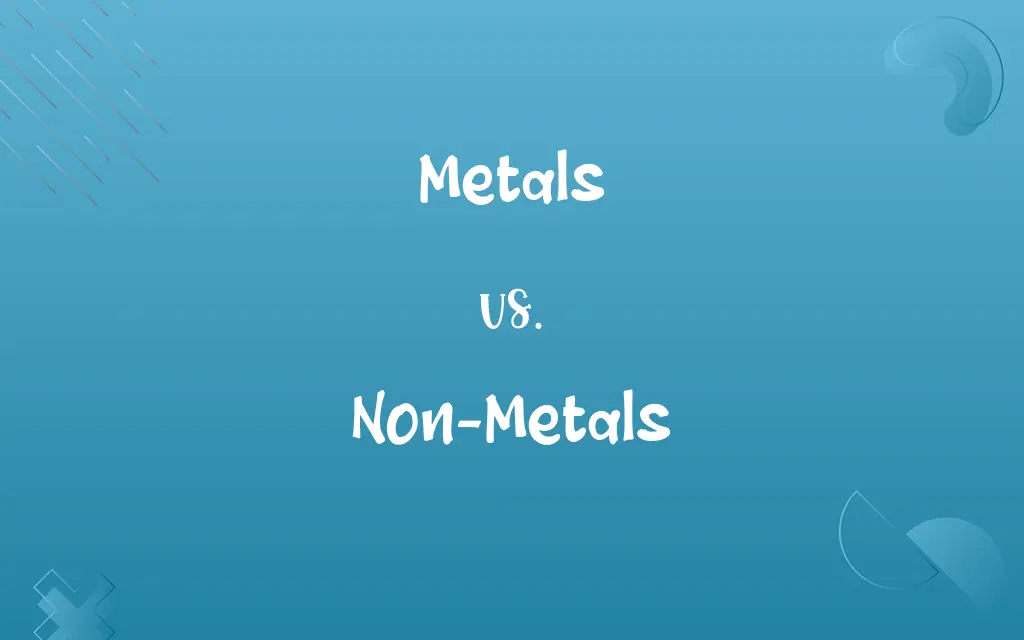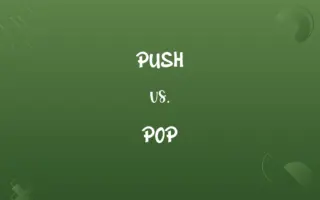Metals vs. Non-Metals: Know the Difference

By Shumaila Saeed || Published on February 21, 2024
Metals are typically hard, conductive, and shiny materials, used in construction and manufacturing, whereas non-metals are generally non-conductive, brittle, and lack metallic luster, found in various forms in nature.

Key Differences
Metals are elements known for their high electrical and thermal conductivity, malleability, ductility, and reflective luster. They tend to lose electrons during chemical reactions. Non-Metals, in contrast, are poor conductors of heat and electricity, are not malleable or ductile, and are more likely to gain electrons during chemical reactions.
Shumaila Saeed
Feb 21, 2024
In the periodic table, Metals occupy the left and middle sections and are characterized by their ability to form positive ions by losing electrons. They are solid at room temperature (except mercury). Non-Metals, found on the right side of the periodic table, can be gases, liquids, or brittle solids at room temperature and tend to form negative ions or covalent compounds.
Shumaila Saeed
Feb 21, 2024
Metals such as iron, copper, and aluminum are widely used in construction and manufacturing due to their strength and durability. They often have a shiny surface when freshly cut or polished. Non-Metals like oxygen, carbon, and sulfur are essential for life and are commonly used in industries like pharmaceuticals and chemicals.
Shumaila Saeed
Feb 21, 2024
Metals often have high melting and boiling points, indicating strong bonds between atoms. They are typically dense and have a high tensile strength. Non-Metals, on the other hand, have lower melting and boiling points and are much less dense compared to metals.
Shumaila Saeed
Feb 21, 2024
The chemical behavior of Metals is largely defined by their tendency to form cations through electron loss. They participate in ionic and metallic bonding. Non-Metals have a diverse range of chemical behaviors, often forming anions or covalent bonds, and participate in a wider variety of chemical reactions.
Shumaila Saeed
Feb 21, 2024
ADVERTISEMENT
Comparison Chart
Physical State
Solid at room temperature (except Hg)
Can be gases, liquids, or brittle solids
Shumaila Saeed
Feb 21, 2024
Conductivity
High electrical and thermal conductivity
Poor conductors of heat and electricity
Shumaila Saeed
Feb 21, 2024
Malleability and Ductility
Highly malleable and ductile
Brittle, not malleable or ductile
Shumaila Saeed
Feb 21, 2024
Chemical Behavior
Lose electrons, form cations
Gain electrons, form anions or covalent compounds
Shumaila Saeed
Feb 21, 2024
ADVERTISEMENT
Metals and Non-Metals Definitions
Metals
Metals are elements that form positive ions by losing electrons.
Iron, a metal, is essential for construction.
Shumaila Saeed
Jan 17, 2024
Non-Metals
Non-Metals can exist in various physical states at room temperature.
Chlorine, a non-metal, is a gas at room temperature.
Shumaila Saeed
Jan 17, 2024
Metals
Metals typically have high melting points.
Steel, an alloy of metals, has a high melting point suitable for building frameworks.
Shumaila Saeed
Jan 17, 2024
Non-Metals
Non-Metals are not malleable or ductile.
Sulfur, a non-metal, is brittle and breaks easily.
Shumaila Saeed
Jan 17, 2024
Metals
Metals are known for their conductivity of heat and electricity.
Copper wires are used extensively for electrical wiring.
Shumaila Saeed
Jan 17, 2024
ADVERTISEMENT
Non-Metals
Non-Metals are elements that generally gain electrons in reactions.
Oxygen, a non-metal, is crucial for respiration.
Shumaila Saeed
Jan 17, 2024
Metals
Metals are malleable and can be shaped into various forms.
Aluminum foil is made by rolling the metal into thin sheets.
Shumaila Saeed
Jan 17, 2024
Non-Metals
Non-Metals are poor conductors of heat and electricity.
Rubber, a non-metal, is used as an electrical insulator.
Shumaila Saeed
Jan 17, 2024
Metals
Any of a category of electropositive elements that usually have a shiny surface, are generally good conductors of heat and electricity, and can be melted or fused, hammered into thin sheets, or drawn into wires. Typical metals form salts with nonmetals, basic oxides with oxygen, and alloys with one another.
Shumaila Saeed
Jan 17, 2024
Non-Metals
Non-Metals often have a lower density compared to metals.
Carbon, in the form of graphite, is a light non-metal.
Shumaila Saeed
Jan 17, 2024
Metals
(rail transport) the rail tracks owned by a company or organisation; a rail network
It was appropriate that 'King' number 6000 began the return to steam on British Rail metals in 1971.
Shumaila Saeed
Jan 17, 2024
Metals
Metals have a characteristic metallic luster.
Silver jewelry shines brightly due to its metallic luster.
Shumaila Saeed
Jan 17, 2024
Repeatedly Asked Queries
What are metals?
Metals are elements that are typically hard, shiny, malleable, ductile, and good conductors of heat and electricity.
Shumaila Saeed
Feb 21, 2024
Can metals be liquid?
Yes, mercury is a metal that is liquid at room temperature.
Shumaila Saeed
Feb 21, 2024
Do metals have high melting points?
Generally, yes. Metals often have high melting points.
Shumaila Saeed
Feb 21, 2024
Are non-metals used in electrical wiring?
No, non-metals are poor conductors and are not typically used in wiring.
Shumaila Saeed
Feb 21, 2024
Do metals have a metallic luster?
Yes, metals typically have a shiny, metallic luster.
Shumaila Saeed
Feb 21, 2024
What are non-metals?
Non-metals are elements that are poor conductors of heat and electricity, and can be gases, liquids, or brittle solids.
Shumaila Saeed
Feb 21, 2024
Do non-metals form anions?
Yes, non-metals often gain electrons to form anions.
Shumaila Saeed
Feb 21, 2024
Are metals magnetic?
Some metals like iron, nickel, and cobalt are magnetic.
Shumaila Saeed
Feb 21, 2024
Can non-metals conduct electricity?
Non-metals are generally poor conductors of electricity.
Shumaila Saeed
Feb 21, 2024
Can metals form cations?
Yes, metals tend to lose electrons and form cations.
Shumaila Saeed
Feb 21, 2024
Is gold a metal?
Yes, gold is a metal known for its ductility and conductivity.
Shumaila Saeed
Feb 21, 2024
Are all non-metals solid at room temperature?
No, non-metals can be gases, liquids, or solids at room temperature.
Shumaila Saeed
Feb 21, 2024
Are non-metals used in fertilizers?
Yes, non-metals like nitrogen and phosphorus are key components of fertilizers.
Shumaila Saeed
Feb 21, 2024
Are metals used in batteries?
Yes, metals like lithium are used in batteries.
Shumaila Saeed
Feb 21, 2024
Do metals react with acids?
Yes, many metals react with acids, often releasing hydrogen gas.
Shumaila Saeed
Feb 21, 2024
Share this page
Link for your blog / website
HTML
Link to share via messenger
About Author
Written by
Shumaila SaeedShumaila Saeed, an expert content creator with 6 years of experience, specializes in distilling complex topics into easily digestible comparisons, shining a light on the nuances that both inform and educate readers with clarity and accuracy.








































































